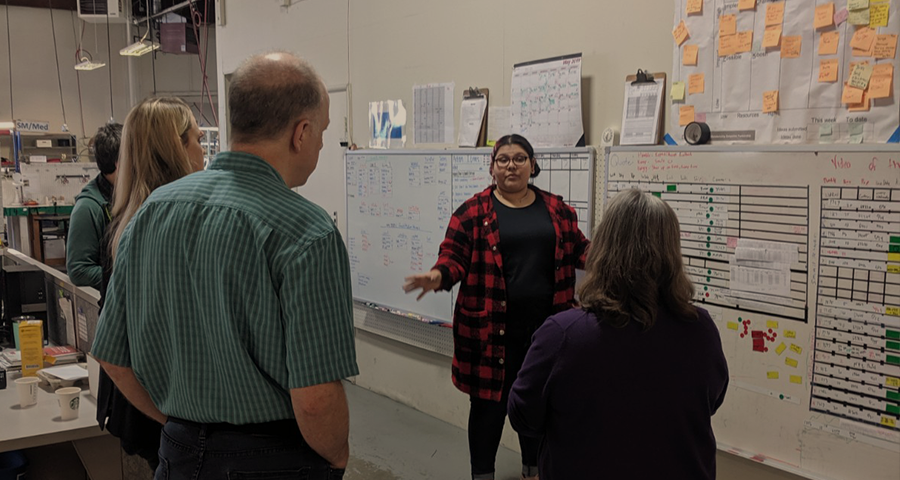THIS IS A GUEST BLOG POST BY MATT FIELDMAN OF AMERICA WORKS, ORIGINALLY PUBLISHED ON THE NIST MANUFACTURING MATTERS BLOG
Some are calling it, “The Great Resignation.” Others are calling it “The Great Reshuffle.” After spending the past year as Executive Director of America Works, I’ve talked with more than 250 manufacturing workforce development professionals throughout the MEP National NetworkTM and our partners. Based on their insights, I’d like to propose a new name: “The Great Recognition.” As I’ll discuss in this post, employees, employers, and workforce development practitioners nationwide are all recognizing either new trends, or the amplification of existing ones, that are disrupting the American workforce in ways that are here to stay. By pivoting from ‘The Great Resignation’ – a negative term that implies that the problem lies with lazy workers – to ‘The Great Recognition,’ which captures how both employers and employees are learning and evolving, we as a nation can begin to directly address these challenges and take action to fill the 900,000 open jobs in manufacturing right now.
Regardless of what you call it, the numbers are staggering: In August alone, 4.3 million workers quit their job. According to The Wall Street Journal, “U.S. workers left their jobs nearly 20 million times between April and August this year, according to the latest federal data, a number more than 60% higher than the resignations handed in during the same period last year, and 12% above the spring and summer of 2019 when the job market was the hottest it had been in almost 50 years.” According to Business Insider, “Job transitions among Gen Z are up 80% year-over-year. For Millennials, they’re up by 50%.”
So why am I proposing we think of this moment in history as “The Great Recognition?” Let’s start with workers, as employees nationwide are realizing:
- Flexibility is key. A recent study showed 76% of workers want greater flexibility, making it the fastest rising priority. Similarly, leisure time is valued by Millennials far more than previous generations, leading younger workers to trade compensation for time and independence. Many workers have learned that working from home is critical to maintaining a good work-life balance, more quality family time, and better mental health.
- Workers want choice. Ask any Uber, Lyft, or DoorDash driver and they’ll tell you flatly: Workers want more choice around who, what, and when they work, preferring “gig” work to the commitment of one specific job all the time. According to Adam Grant, “Real flexibility is having autonomy to choose your people, your purpose and your priorities.”
- Remote work is here to stay. In fact, quitting your job and starting a new one remotely just isn’t that big a deal. I have friends that have onboarded twice in the past 18-plus months of the pandemic and can tell you they feel as integrated into their virtual organizations as they ever did in person.
Essentially, the turbulence of the past 18-plus months has led many workers, particularly those in low-wage jobs, “to reconsider what matters most in life, ultimately causing the workforce to shift.” At the same time, employers are going through their own Great Recognition, focusing on:
- Improving supervision. Gallup found that “it takes more than a 20% pay raise to lure most employees away from a manager who engages them, and next to nothing to poach most disengaged workers.”
- Improving job quality. Job quality matters, and employers should understand what it is. The days of having an employee pack boxes all day are long over; today’s workers want interesting jobs, and interesting people to work alongside. As Ann Kowal Smith, Executive Director of Reflection Point, put it so eloquently recently, “People are lonely. They want flexibility but they also want belonging. They want meaningful work, but they also want meaningful relationships.”
- We need creativity to solve the workforce crisis. We got into this mess because of a lack of creativity; only workforce innovation will get us out of it. Exciting nonprofits that specialize in training underserved populations, like the Uniquely Abled Project and Manufacturing Renaissance, need to scale nationally and connect with more employers.
- Diversity, equity, and inclusion are not just buzzwords. Rather, re-evaluating your workplace culture and incorporating new, more inclusive practices are both essential to maintaining a welcoming and safe environment for all workers.
- WorkPLACE development is the new workFORCE development. The culture of an organization, and how it manifests in everyday interactions, is more important than ever. And the never-ending quest to become an “employer of choice” – where employees recommend their friends and family to work at your company – is more of a priority than in the past. This recent study from Indiana documented real practices at real manufacturers that are working to retain workers, with best-in-class companies experiencing less than 15% turnover.
Let me be clear: Small manufacturers are ahead of the game here. Our four-day workweeks and flexible shifts can be very attractive to younger workers, working moms, and more. Companies that can rotate people through various jobs, and offer choice and new skill development, are exciting to many workers. Why not lead with that? And, while social connections may not be as motivating to younger workers as they were to previous generations, that doesn’t mean we should ignore them completely. Introducing new employees around your small company, and making time for them to build relationships, will make them feel valued and that they belong in your workplace.
At the same time, this moment has challenged small manufacturers to think of how they approach both their workforce, and the work itself. Can we learn from the Uber model and turn certain aspects of manufacturing into “gig work”? Can we offer more flexibility, meaning, belonging, and innovation in our workplaces? And given that these are tall orders for any company, what might we do to compensate for what we can’t change?
Regardless of what we call it, today’s workforce challenges constitute a Great Recognition, a Great Realization, and a Great Reckoning. I’ll let Amanda Cage, CEO of the National Fund for Workforce Solutions, have the last word: “It is time to build an economy around working people; one that is holistic and recognizes workers’ humanity. I’m hopeful that we can get there together.”




